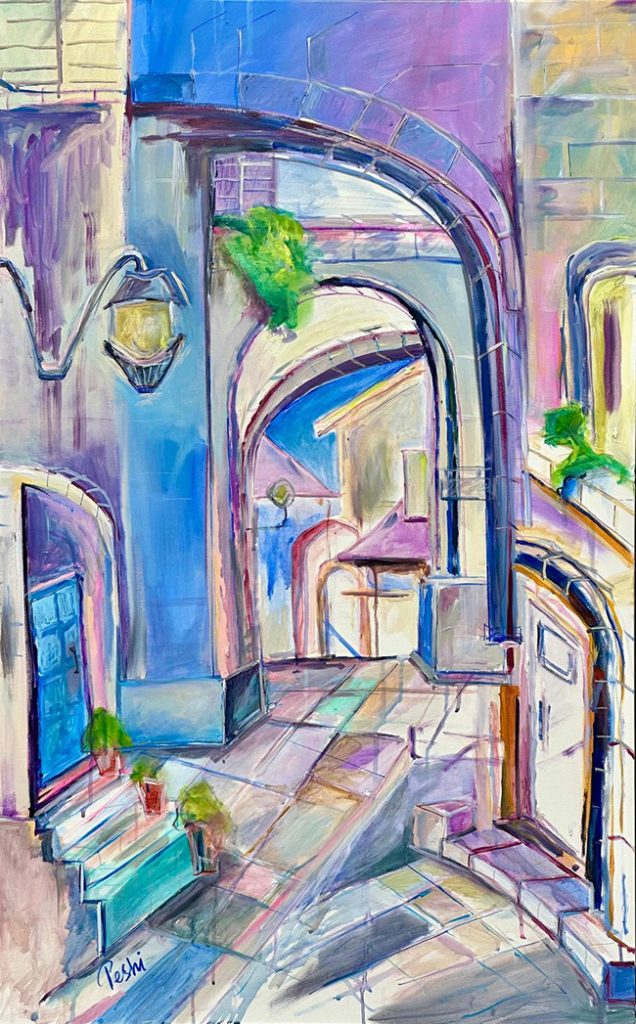Peshi Haas doesn’t just paint places—she builds them on canvas. Her art isn’t about reproducing what already exists; it’s about uncovering the soul of a space and bringing it to life in a way that feels both abstract and architectural. She works like a traveler with a sketchbook and a compass made of color and memory, building structures that blur the line between observation and invention.

A graduate of the School of Visual Arts (SVA), Haas has developed a visual language rooted in curiosity and exploration. She’s drawn to places that most people walk by without noticing: crumbling alleyways, tucked-away streets, the edges where cities start to dissolve into themselves. These are the kinds of spaces she transforms into art. Her focus on abstract architecture is not just a stylistic choice—it’s a philosophy. She treats structure as something flexible, something to be reimagined. By blending her love of travel with her painter’s eye, Haas continues to create work that asks viewers to slow down and really look.
One of her latest pieces—an acrylic and oil stick painting based on a hidden street in Jerusalem’s Old City—is a vivid example of this. It’s a large-scale work, but it feels intimate. The composition is built around a glowing, abstract archway, a visual anchor that draws the viewer inward. Beneath the arch, the suggestion of cobblestones leads the eye toward the center of the painting, like a map directing you through the winding layers of the city.
The palette is bold. Bright yellows meet rich purples in a dance of complementary contrast. Haas is clearly drawn to color not just for its visual punch, but for its emotional weight. Yellow feels like sun, warmth, presence. Purple adds mystery, shadow, and distance. These opposites don’t fight—they talk to each other, giving the work a sense of movement and depth.
There’s an almost musical rhythm to the way lines are laid across the painting. Some are structural, hinting at alleyways, rooftops, or doorframes. Others are looser, more gestural. Awnings curve and stretch like sails, casting abstract shadows. Lanterns appear, not as detailed objects, but as quiet shapes hanging in the air. Haas isn’t interested in photorealism; she’s reaching for something else—a feeling of place, rather than a picture of it.
She describes her process as immersive. In this case, it meant spending weeks soaking up the street’s atmosphere before translating it onto the canvas. “I immersed myself in the atmosphere of this location,” she says, “allowing me to be more present as I painted.” It’s a kind of slow seeing, where being present means taking the time to absorb what others might overlook.
Though the painting is rooted in Jerusalem, it carries traces of other places Haas has visited and painted over the past 25 years. She has long been fascinated by old cities—across Asia, Europe, and the Middle East—and often returns to recurring motifs like pathways, archways, and architectural fragments. These elements form a kind of personal language in her work, connecting different cities through abstract shapes and overlapping memories.
What’s most striking is how she mixes real observation with invention. The streets, walls, and rooftops in the painting don’t exist in this exact way, but they feel true. They’re built from memory, from sensory experience, and from her long-standing relationship with the places she paints. “While this is a hidden street in Jerusalem’s old city,” she says, “my imagination took me further.” That “further” is where her art lives.
In Haas’s work, structure becomes story. The way a shadow falls, the curve of an awning, the placement of a lantern—these are the things that shape how we experience space. And by painting them in this loose, abstracted way, Haas encourages viewers to bring their own imagination into the frame.
It’s not just about looking at a painting. It’s about walking into it.


